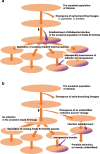Two Complete Genomes of Male-Killing Wolbachia Infecting Ostrinia Moth Species Illuminate Their Evolutionary Dynamics and Association with Hosts
- PMID: 36810610
- PMCID: PMC10497655
- DOI: 10.1007/s00248-023-02198-7
Two Complete Genomes of Male-Killing Wolbachia Infecting Ostrinia Moth Species Illuminate Their Evolutionary Dynamics and Association with Hosts
Abstract
Wolbachia is an extremely widespread intracellular symbiont which causes reproductive manipulation on various arthropod hosts. Male progenies are killed in Wolbachia-infected lineages of the Japanese Ostrinia moth population. While the mechanism of male killing and the evolutionary interaction between host and symbiont are significant concerns for this system, the absence of Wolbachia genomic information has limited approaches to these issues. We determined the complete genome sequences of wFur and wSca, the male-killing Wolbachia of Ostrinia furnacalis and Ostrinia scapulalis. The two genomes shared an extremely high degree of homology, with over 95% of the predicted protein sequences being identical. A comparison of these two genomes revealed nearly minimal genome evolution, with a strong emphasis on the frequent genome rearrangements and the rapid evolution of ankyrin repeat-containing proteins. Additionally, we determined the mitochondrial genomes of both species' infected lineages and performed phylogenetic analyses to deduce the evolutionary dynamics of Wolbachia infection in the Ostrinia clade. According to the inferred phylogenetic relationship, two possible scenarios were proposed: (1) Wolbachia infection was established in the Ostrinia clade prior to the speciation of related species such as O. furnacalis and O. scapulalis, or (2) Wolbachia infection in these species was introgressively transferred from a currently unidentified relative. Simultaneously, the relatively high homology of mitochondrial genomes suggested recent Wolbachia introgression between infected Ostrinia species. The findings of this study collectively shed light on the host-symbiont interaction from an evolutionary standpoint.
Keywords: Bacterial endosymbiont; Genome rearrangement; Horizontal transmission; Introgression; Lepidoptera; Mitochondrial genome.
© 2023. The Author(s).
Conflict of interest statement
The authors declare no competing interests.
Figures






Similar articles
-
Two kinds of sex ratio distorters in a moth, Ostrinia scapulalis.Genome. 2003 Dec;46(6):974-82. doi: 10.1139/g03-083. Genome. 2003. PMID: 14663516
-
Feminizing Wolbachia in an insect, Ostrinia furnacalis (Lepidoptera: Crambidae).Heredity (Edinb). 2002 Jun;88(6):444-9. doi: 10.1038/sj.hdy.6800077. Heredity (Edinb). 2002. PMID: 12180086
-
Transfection of Wolbachia in Lepidoptera: the feminizer of the adzuki bean borer Ostrinia scapulalis causes male killing in the Mediterranean flour moth Ephestia kuehniella.Proc Biol Sci. 2001 Apr 22;268(1469):855-9. doi: 10.1098/rspb.2001.1593. Proc Biol Sci. 2001. PMID: 11345332 Free PMC article.
-
Wolbachia genomes: revealing the biology of parasitism and mutualism.Trends Parasitol. 2006 Feb;22(2):60-5. doi: 10.1016/j.pt.2005.12.012. Epub 2006 Jan 10. Trends Parasitol. 2006. PMID: 16406333 Review.
-
A Worked Example of Screening Genomic Material for the Presence of Wolbachia Infection.Methods Mol Biol. 2024;2739:275-299. doi: 10.1007/978-1-0716-3553-7_17. Methods Mol Biol. 2024. PMID: 38006558 Review.
Cited by
-
Two male-killing Wolbachia from Drosophila birauraia that are closely related but distinct in genome structure.R Soc Open Sci. 2024 Jan 10;11(1):231502. doi: 10.1098/rsos.231502. eCollection 2024 Jan. R Soc Open Sci. 2024. PMID: 38204789 Free PMC article.
-
Cell-based assays and comparative genomics revealed the conserved and hidden effects of Wolbachia on insect sex determination.PNAS Nexus. 2024 Aug 22;3(9):pgae348. doi: 10.1093/pnasnexus/pgae348. eCollection 2024 Sep. PNAS Nexus. 2024. PMID: 39228812 Free PMC article.
-
Complete De Novo Assembly of Wolbachia Endosymbiont of Frankliniella intonsa.Int J Mol Sci. 2023 Aug 26;24(17):13245. doi: 10.3390/ijms241713245. Int J Mol Sci. 2023. PMID: 37686049 Free PMC article.
-
Suppression of cytoplasmic incompatibility in the leaf-mining fly Liriomyza sativae with a nuclear Wolbachia insert.R Soc Open Sci. 2025 May 21;12(5):242137. doi: 10.1098/rsos.242137. eCollection 2025 May. R Soc Open Sci. 2025. PMID: 40400517 Free PMC article.
References
-
- Goryacheva I, Andrianov B. Reproductive parasitism in insects. The interaction of host and bacteria. Biol Commun. 2021;66:17–27. doi: 10.21638/spbu03.2021.103. - DOI
MeSH terms
Grants and funding
LinkOut - more resources
Full Text Sources

